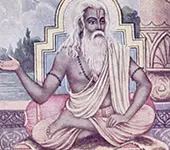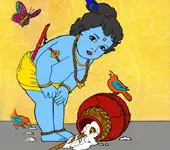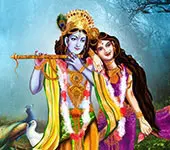This audio tells you about how the meaning of the Gayatri mantra is hidden in the first shloka of Bhagavata.
Quiz
Which among these is NOT generally recommended for bhaktas ?Transcript
(Click here to read more)
जन्माद्यस्य यतोऽन्वयादितरतश्चार्थेष्वभिज्ञः स्वराट् तेने ब्रह्म हृदा य आदिकवये मुह्यन्ति यत्सूरयः। तेजोवारिमृदां यथा विनिमयो यत्र त्रिसर्गोऽमृषा धाम्ना स्वेन सदा निरस्तकुहकं सत्यं परं धीमहि॥ We have already seen that Bhagavata tells us abou....
Transcript
(Click here)
जन्माद्यस्य यतोऽन्वयादितरतश्चार्थेष्वभिज्ञः स्वराट् तेने ब्रह्म हृदा य आदिकवये मुह्यन्ति यत्सूरयः।
तेजोवारिमृदां यथा विनिमयो यत्र त्रिसर्गोऽमृषा धाम्ना स्वेन सदा निरस्तकुहकं सत्यं परं धीमहि॥
We have already seen that Bhagavata tells us about the nature of man.
How maya binds him and how bhakti releases him.
And also that to have bhakti, we should know the greatness of the Lord, then only bhakti will come.
Have you noticed this?
Your highest affection is towards yourself.
You may talk about selflessness, service to mankind, but all these have a limit.
You can give up on everyone: your parents, children, partner, depends on the circumstance.
We see this happening, every day.
That is human nature.
But you can never give up on yourself.
Your concern for the well-being of yourself: physical, mental, spiritual, every single act that we do is meant for this.
Even when you do selfless charity, ultimately it has a purpose, that I want to go to a Punyaloka, or I want divine grace, or I want peace of mind.
without this I at the center, at the core, there is no action, there is no thought.
Everything is related to I- अहं
If a lever has to function, it has to rest at some place.
If a wheel has to rotate, it needs a center.
This is I, the core of all your actions, all your thoughts, the core of your existence.
Bhagavata would make you turn this highest of affection of yours which is towards yourself, to turn this itself into the ultimate love for Bhagawan.
So, you don’t have to bring in bhakti from somewhere.
You don’t have to cultivate it, make it grow.
It is already within you as powerful as a volcano ready to explode.
Bhagavata would make this happen.
Bhagavata would turn this great force within you into bhakti.
After this your focus will not be on I, your focus will be on Bhagavan.
Your love will not be for yourself, your love will be for Bhagawan, the direction changes.
And in some time, you would also realize that the I at your core is also none other than Bhagavan.
Now we will see how the first shloka of Bhagavata stands for the meaning of Gayatri Mantra:
The meaning of the first shloka, janmadyaysa is:
We meditate upon that supreme truth, Parabrahma who is the cause of everything, who knows everything, who handed over Vedas to Brahma for effecting creation, and who removes all ignorance with his brilliance which is knowledge.
तत्सवितुर्वरेण्यमित्याह प्रसूत्या- this is what Veda says.
Prasooti means prasava, giving birth.
See the connection prasava-savita; सविता in saviturvarenyam.
सर्वलोकप्रसवनात् सविता।
सविता प्रसवानामधिपतिः ।
Surya is called Savita because he gives birth to the world.
Here in the shloka also janmadyasya: janmadi- janma etc, same prasooti, prasava.
Then we have devasya in Gayatri; bhargo devasya.
द्योतयति इति देवः।
Dyotayati means prakshayati- throws light upon, reveals.
That's knowledge.
We are able to recognize objects when Suryadeva throws light upon them.
That's why he is called Deva; he gives knowledge, from basic knowledge to the ultimate knowledge.
Here, in the shloka also अर्थेष्वभिज्ञः।
अभिज्ञः - knowledgeable.
Then वरेण्यम् in Gayatri; varenyam means shreshta, great.
We admire those who are great.
We develop respect and admiration towards someone who is great.
We start loving them, this is bhakti.
This great person here is Brahma, Parabrahma, Sri Hari, and he is also the greatest truth; सत्यं परं धीमहि
There is this term भर्गः in Gayatri Mantra; भर्गो देवस्य।
भर्जयत्यखिलाऽविद्याम्
Bharga removes all avidya, all ajnana, all ignorance.
In the shloka also, तेजोवारिमृदां यथा विनिमयः।
This is ajnana.
This is ajnana to see water in hot air, in the mirage, to confuse water for mirror, a shiny surface for water, this is avidya.
धाम्ना स्वेन सदा निरस्तकुहकम्।
And he removes all this avidya, ignorance.
So he is Bharga.
तेजोवारिमृदां यथा विनिमयो यत्र त्रिसर्गोऽमृषा धाम्ना स्वेन सदा निरस्तकुहकं - this stands for Bharga of Gayatri Mantra.
Dheemahi is there both in Gayatri and the shloka.
Dheemahi means- we meditate upon.
What is meditation?
धियस्सर्वेन्द्रियाण्येव मनसा सह सर्वदा प्रेरयेत् यस्समस्तानां तद्ध्यानं सर्वथा हितम्।
To give prerana to mind, intelligence, and sensory organs towards the object of dhyana, meditation, towards the object upon which we are meditating.
This prerana is प्रचोदयात् in Gayatri mantra.
धियों यो नः प्रचोदयत्।
So right at the beginning, Sage Vyasa is telling that Veda, Bhagavata, and Gayatri, they are one and the same.
Recommended for you
Lord Rama shows us how to live
 Click here to know more..
Click here to know more..
Brahmahatya

Brahmahatya is personified as a demoness in the Puranas. She is very fierce. She roars and laughs out loudly. ....
Click here to know more..Eka Sloki Mahabharata

Aadau paand'avadhaartaraasht'rajananam laakshaagri'he daahanam Dyoote shreeharanam vane viharanam matsyaalaye vartanam . Leelaagograhanam rane viharan....
Click here to know more..
English Topics
Bhagavatam
Click on any topic to open
- 65 Bhagavan's External Deeds
- 64 Is the Body Yours?
- 63 What's So Great About The Stories Of Sri Krishna
- 62 What To Do If You Just Don't Have Interest In Bhagawan
- 61 Which God Should I Worship?
- 60 How To Observe Dharma Properly
- 59 Devotee's progress
- 58 Which Guruji Can You Trust
- 57 Bhagawan Is Beyond Human Comprehension
- 56 The Missing Piece: Why Your Spiritual Practices Are Not Working
Please wait while the audio list loads..
30
Ganapathy
Shiva
Hanuman
Devi
Vishnu Sahasranama
Mahabharatam
Practical Wisdom
Yoga Vasishta
Vedas
Rituals
Rare Topics
Devi Mahatmyam
Glory of Venkatesha
Shani Mahatmya
Story of Sri Yantra
Rudram Explained
Atharva Sheersha
Sri Suktam
Kathopanishad
Ramayana
Mystique
Mantra Shastra
Bharat Matha
Bhagavatam
Astrology
Temples
Spiritual books
Purana Stories
Festivals
Sages and Saints
